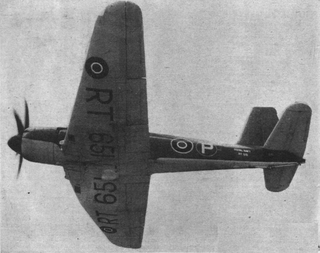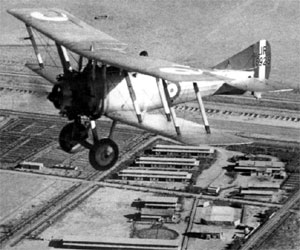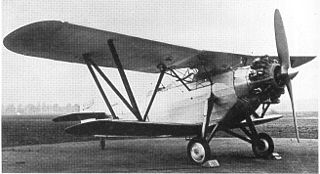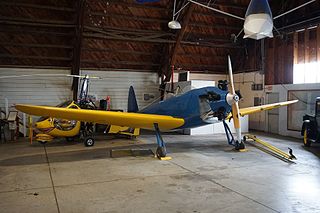Related Research Articles

The Centaurus was the final development of the Bristol Engine Company's series of sleeve valve radial aircraft engines. The Centaurus is an 18-cylinder, two-row design that eventually delivered over 3,000 hp (2,200 kW). The engine was introduced into service late in the Second World War and was one of the most powerful aircraft piston engines to see service.

Folland Aircraft was a British aircraft manufacturing company which was active between 1937 and 1963.

The Hawker Hart is a British two-seater biplane light bomber aircraft that saw service with the Royal Air Force (RAF). It was designed during the 1920s by Sydney Camm and manufactured by Hawker Aircraft. The Hart was a prominent British aircraft in the inter-war period, but was obsolete and already side-lined for newer monoplane aircraft designs by the start of the Second World War, playing only minor roles in the conflict before being retired.

The Fairey Aviation Company Fairey III was a family of British reconnaissance biplanes that enjoyed a very long production and service history in both landplane and seaplane variants. First flying on 14 September 1917, examples were still in use during the Second World War.

The Vickers Type 56 Victoria was a British biplane freighter and troop transport aircraft used by the Royal Air Force. The Victoria flew for the first time in 1922 and was selected for production over the Armstrong Whitworth Awana.

The Hawker Horsley was a British single-engined biplane bomber of the 1920s. It was the last all-wooden aircraft built by Hawker Aircraft, and served as a medium day bomber and torpedo bomber with Britain's Royal Air Force between 1926 and 1935, as well as the navies of Greece and Denmark.

The Airspeed AS.39 Fleet Shadower was a British long-range patrol aircraft design that did not go beyond the prototype stage. A similar aircraft, the General Aircraft Fleet Shadower, was also built to the extent of prototypes. While the concept of a fleet shadower had some promise, the resulting designs were soon overtaken by wartime developments in airborne radar.

The Blackburn B.48 Firecrest, given the SBAC designation YA.1, was a single-engine naval strike fighter built by Blackburn Aircraft for service with the British Fleet Air Arm during the Second World War. It was a development of the troubled Firebrand, designed to Air Ministry Specification S.28/43, for an improved aircraft more suited to carrier operations. Three prototypes were ordered with the company designation of B-48 and the informal name of "Firecrest", but only two of them actually flew. The development of the aircraft was prolonged by significant design changes and slow deliveries of components, but the determination by the Ministry of Supply in 1946 that the airframe did not meet the requirements for a strike fighter doomed the aircraft. Construction of two of the prototypes was continued to gain flight-test data and the third was allocated to strength testing. The two flying aircraft were sold back to Blackburn in 1950 for disposal and the other aircraft survived until 1952.

The de Havilland DH.50 was a 1920s British large single-engined biplane transport built by de Havilland at Stag Lane Aerodrome, Edgware, and licence-built in Australia, Belgium, and Czechoslovakia.

The Fokker F.IX was an airliner developed in the Netherlands in the late 1920s, intended to provide KLM with an aircraft suitable for regular services to the Dutch East Indies. When the onset of the Great Depression forced the postponement of those plans, the market for this aircraft disappeared as well, although it did see military service in Czechoslovakia as a bomber.

The General Aircraft Monospar ST-25 was a British 1930s light twin-engined utility aircraft.

The Nieuport Nighthawk was a British fighter aircraft developed by the Nieuport & General Aircraft company for the Royal Air Force towards the end of the First World War. Although ordered into production before the aircraft first flew, it did not enter large scale service with the RAF owing to unreliable engines. Re-engined aircraft did see service in Greece, serving from 1923 to 1938.

The Dornier Komet (Comet), Merkur (Mercury), Do C, Do D, and Do T were a family of aircraft manufactured in Germany during the 1920s, originally as small airliners, but which saw military use as well. The earliest aircraft in the series were basically landplane versions of the Delphin flying boat, and although the Delphin and Komet/Merkur series diverged from each other, design changes and refinements from one family were often incorporated into the other. All variants were braced high-winged single-engine monoplanes with conventional landing gear.

The Bristol Type 72 Racer was a British racing monoplane designed by Wilfrid Thomas Reid and built by the Bristol Aeroplane Company at Filton, England.

The Bristol Type 118 was a general-purpose military aircraft, a two-seat biplane built by the Bristol Aeroplane Company in the early 1930s, powered by a Bristol Mercury radial engine and aimed at overseas markets. The Type 120 was a Bristol Pegasus-engined variant entered into an Air Ministry competition and later used for armament tests. Two aircraft were built.

The Cody IV monoplane was a single-engined monoplane designed and built by the American-born but British-based aviation pioneer Samuel Franklin Cody in 1912. It was intended for entry into the 1912 British Military Aeroplane Competition, but was wrecked in a crash before the start of the competition.

The Rohrbach Ro IV, also known as the Beardmore BeRo.2 Inverness was an all-metal monoplane flying boat of the 1920s. Designed by the German company Rohrbach for the British Royal Air Force, two were ordered, one completed by Rohrbach's Danish subsidiary and the second by the British licensees, William Beardmore and Company, but the type performed poorly during testing and was abandoned.

The Howard DGA-18 was an American two-seat basic training aircraft designed and built by the Howard Aircraft Corporation for the United States Civil Pilot Training Program.

The Hillson Bi-mono was a British experimental aircraft of the 1940s. It was designed to test the idea of "slip-wings", where the aircraft could take off as a biplane, jettison the upper, disposable wing, and continue flying as a monoplane. A single example was built, which successfully demonstrated jettisoning of the slip wing in flight.

A testbed aircraft is an aeroplane, helicopter or other kind of aircraft intended for flight research or testing the aircraft concepts or on-board equipment. These could be specially designed or modified from serial production aircraft.
References
Notes
- ↑ Buttler (2004) British Secret Projects - Fighters and Bombers 1935-1950 Midland Publishing 1-85780-179-2 p228
- ↑ Jarrett Aeroplane Monthly June 1991, p. 354
- ↑ "Aero Engines - Napier" Flight, 27 June 1958 p898
- 1 2 Willis, David (January 2009). "Folland's 'Frightener'". FlyPast (330). Stamford, Lincolnshire, England: Key Publishing: 60. ISSN 0262-6950.
- 1 2 Halley 1996, p. 12.
- ↑ "Flying Test Bed", Flight: 591, 13 June 1946
- ↑ Bridgman, Leonard, ed. (1989). Jane's Fighting aircraft of World War II (1995 ed.). New York: Military Press. p. 121. ISBN 0517679647.
- 1 2 3 Jarrett Aeroplane Monthly June 1991, p. 357
Bibliography
- Ford, Daniel (July–August 2001). "Folland's 'Frightful': The Fo 108 Engine Test-Bed". Air Enthusiast . No. 94. pp. 40–41. ISSN 0143-5450.
- Green, Peter (September–October 2001). "Round-Out". Air Enthusiast . No. 95. p. 79. ISSN 0143-5450.
- Halley, J. J. Royal Air Force Aircraft P1000-R9999. Tonbridge, Kent, UK: Air-Britain (Historians) Ltd., 1996. ISBN 0-85130-235-1.
- Jarrett, Philip (June 1991). "Nothing Ventured...No. 15". Aeroplane Monthly . Vol. 19, no. 6. pp. 354–358. ISSN 0143-7240.